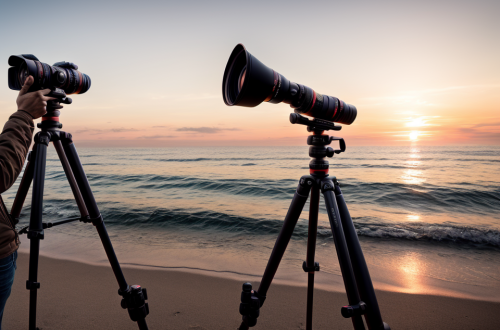Photography is an art form that allows us to capture and freeze moments in time, telling stories through images. But to truly master this art, one must first understand the importance of photography concepts. Photography concepts go beyond the technical aspects of shooting and encompass the ideas, themes, and messages that photographers want to convey through their work. It is the foundation of creative expression in photography, and it’s what sets great photographers apart from the rest. In this article, we will explore the different ways photographers can develop and refine their photography concepts, unlocking their full creative potential. So, whether you’re a seasoned pro or just starting out, join us as we dive into the world of photography concepts and discover how to make your images truly stand out.
Developing a Photography Concept
Identifying Your Vision
- Understanding your goals and aspirations as a photographer
- It is crucial to have a clear understanding of what you want to achieve through your photography. This may include capturing stunning landscapes, telling compelling stories through portraits, or showcasing the beauty of nature through still life images. Whatever your goals may be, it is important to have a clear vision of what you want to create.
- Recognizing your unique perspective and style
- Every photographer has a unique perspective and style that sets them apart from others. It is essential to recognize and embrace your own unique perspective and style. This may involve experimenting with different techniques, exploring new genres, or developing your own signature style. By recognizing your unique perspective and style, you can create images that are truly distinctive and memorable.
- Experimenting with different genres and techniques
- Experimenting with different genres and techniques is an important part of developing your photography concept. This may involve trying out different styles, such as landscape, portrait, still life, or documentary photography. It may also involve experimenting with different techniques, such as using unusual angles, experimenting with lighting, or using unconventional props and settings. By experimenting with different genres and techniques, you can broaden your creative horizons and develop a more well-rounded photography concept.
Conducting Research
When it comes to developing a photography concept, conducting research is an essential step in the process. Here are some ways to do it:
Exploring the Work of Other Photographers for Inspiration
One of the best ways to get inspired is by exploring the work of other photographers. This can help you see different approaches to photography and can spark new ideas for your own work. To get started, look for photographers whose work you admire and study their images. Pay attention to the composition, lighting, and subject matter. Consider how they use different techniques to create their images and how you can apply these techniques to your own work.
Studying the Elements of Composition and Design
Another way to conduct research is by studying the elements of composition and design. This includes understanding the rule of thirds, leading lines, symmetry, and other principles that can help you create visually appealing images. You can find many resources online that explain these principles in detail. Take the time to learn and understand these concepts, and then experiment with them in your own work.
Familiarizing Yourself with the Latest Trends and Technologies
Finally, it’s important to stay up-to-date with the latest trends and technologies in photography. This can help you incorporate new techniques and ideas into your work. Keep an eye on photography blogs, magazines, and social media to stay informed. Attend photography workshops and events to network with other photographers and learn new techniques. By staying informed, you can continue to develop your skills and improve your work.
Brainstorming Ideas
- Utilizing brainstorming techniques: Brainstorming is a proven method for generating new ideas and concepts. It involves writing down as many ideas as possible in a short amount of time, without evaluating or judging them. This can help you come up with unique and innovative concepts for your photography.
- Experimenting with different themes and subjects: To develop a strong photography concept, it’s important to experiment with different themes and subjects. This can help you find your unique voice and style as a photographer, and allow you to create images that stand out from the crowd.
- Creating mood boards and storyboards: Mood boards and storyboards are visual tools that can help you organize and visualize your ideas. They can be used to gather inspiration, plan out your shots, and create a cohesive concept for your photography project. By creating a mood board or storyboard, you can better understand your vision and communicate it to others.
Building a Photography Concept
Defining Your Concept
Defining your concept is a crucial step in the process of creating a successful photography project. It involves clarifying your vision and message, identifying the key elements of your concept, and determining the tone and mood of your photography.
Clarifying your vision and message
Before you start taking photographs, it’s important to have a clear idea of what you want to communicate through your work. This can involve considering the themes and subjects that interest you, as well as the message or emotion that you want to convey to your audience.
Identifying the key elements of your concept
Once you have a clear vision for your project, you need to identify the key elements that will bring your concept to life. This might include specific locations, subjects, props, or lighting techniques that will help to communicate your message.
Determining the tone and mood of your photography
The tone and mood of your photography can have a significant impact on the way that your work is perceived by your audience. It’s important to consider the emotions and feelings that you want to evoke through your images, and to choose a tone that is appropriate for your concept.
For example, if you’re creating a series of photographs that explore the theme of nostalgia, you might choose a tone that is melancholic and reflective. On the other hand, if you’re creating a series of photographs that celebrate the beauty of nature, you might choose a tone that is uplifting and joyful.
Overall, defining your concept is a critical step in the process of creating a successful photography project. By clarifying your vision, identifying the key elements of your concept, and determining the tone and mood of your photography, you can create images that are powerful, meaningful, and impactful.
Developing a Plan
When developing a plan for your photography concept, it is important to outline the steps necessary to execute your idea. This will help you stay organized and ensure that you have all the necessary resources and equipment to bring your concept to life. Here are some key steps to consider when developing a plan for your photography concept:
- Identify the main elements of your concept: What is the subject matter? What is the message you want to convey? What style or technique will you use to achieve your vision?
- Break down the concept into smaller, manageable tasks: This will help you identify potential challenges and solutions, as well as set realistic goals and deadlines for each task.
- Create a timeline: Once you have broken down your concept into smaller tasks, create a timeline for when each task needs to be completed. This will help you stay on track and ensure that you have enough time to complete each task.
- Identify potential challenges and solutions: Think about potential challenges that may arise during the execution of your concept, and come up with solutions to overcome them. This will help you avoid roadblocks and stay focused on your goal.
- Set realistic goals and deadlines: Be realistic about what you can achieve within the time frame you have, and set achievable goals for each task. This will help you stay motivated and avoid burnout.
By following these steps, you can develop a solid plan for your photography concept that will help you stay organized and focused throughout the creative process.
Gathering Necessary Resources
Acquiring the necessary equipment and accessories
- Determine the type of photography you want to pursue and the equipment required for it.
- Research different brands and models of cameras, lenses, and other accessories to find the best fit for your needs and budget.
- Consider factors such as image quality, versatility, and durability when making your selection.
- Invest in high-quality equipment to ensure that you get the best results possible.
Locating and scouting locations
- Identify the type of environment that best suits your photography concept.
- Research potential locations and scout them in person to determine their suitability.
- Consider factors such as lighting, background, and available amenities when selecting a location.
- Plan your shoot in advance to ensure that you have enough time to set up and capture the shots you need.
Recruiting models or subjects
- Determine the type of subject you need for your photography concept.
- Research potential models or subjects and evaluate their suitability for your project.
- Consider factors such as age, gender, ethnicity, and experience when selecting a model or subject.
- Communicate clearly with your model or subject to ensure that they understand your vision and are comfortable with the shoot.
Executing Your Photography Concept
Capturing the Images
Capturing the images is a crucial step in the process of executing your photography concept. This section will delve into the various techniques and styles that can be used to capture the perfect image, as well as the importance of paying attention to lighting, composition, and post-processing.
Utilizing Different Techniques and Styles
When it comes to capturing images, there are a variety of techniques and styles that can be used to achieve the desired result. For example, using a wide-angle lens can create a sense of depth and grandeur, while a telephoto lens can be used to focus on a specific subject in the image. Experimenting with different techniques and styles can help you find the perfect fit for your concept.
Paying Attention to Lighting
Lighting is one of the most important factors in capturing a great image. Paying attention to the quality and direction of light can greatly impact the mood and overall feel of the image. Whether it’s natural light or artificial light, understanding how to use light to your advantage is essential to achieving the desired result.
Composition
Composition is another key element in capturing the perfect image. It involves arranging the visual elements in a way that is aesthetically pleasing and effectively communicates the concept. Considering the rule of thirds, leading lines, and other composition techniques can help create a dynamic and engaging image.
Post-Processing
Post-processing is the final step in capturing the perfect image. It involves editing the image to enhance its overall look and feel. This can include adjusting the exposure, contrast, and color balance, as well as removing any unwanted elements from the image.
Experimenting with Different Angles and Perspectives
Experimenting with different angles and perspectives can also help bring your concept to life. Whether it’s shooting from a low angle to create a sense of power and strength, or from a high angle to create a sense of vulnerability and weakness, experimenting with different angles and perspectives can add depth and interest to your images.
In conclusion, capturing the perfect image requires a combination of techniques, styles, lighting, composition, and post-processing. By paying attention to these elements and experimenting with different angles and perspectives, you can bring your photography concept to life and create stunning images that capture the essence of your vision.
Presenting Your Work
Editing and Selecting the Best Images
- Carefully reviewing your work
- Considering factors such as composition, lighting, and subject matter
- Eliminating any irrelevant or low-quality images
- Creating a strong and cohesive collection of images
Presenting Your Work in a Cohesive and Compelling Manner
- Creating a narrative or theme for your work
- Organizing your images in a logical and visually appealing way
- Using layout and design principles to enhance the impact of your images
- Choosing the appropriate medium or platform to showcase your work
Sharing Your Work with Others and Receiving Feedback
- Seeking out opportunities to exhibit your work in galleries or online platforms
- Engaging with your audience and being open to constructive criticism
- Collaborating with other photographers or artists to learn from their perspectives
- Continuously refining and evolving your work based on feedback and personal growth.
Refining Your Photography Concept
Evaluating Your Work
Evaluating your work is a crucial step in refining your photography concept. It allows you to objectively analyze your images and identify areas for improvement. Here are some tips on how to evaluate your work effectively:
- Look for technical errors: Technical errors such as incorrect exposure, focus, and composition can detract from the overall quality of your image. Review your images and make note of any technical errors that you need to correct in the future.
- Assess your composition: Consider the rules of composition such as the rule of thirds, leading lines, and balance. Analyze how well you have applied these principles in your images and if there are any areas where you can improve.
- Examine your lighting: Lighting is a critical element in photography, and it can make or break an image. Review your images and evaluate your use of light. Consider if you have used the appropriate lighting for the scene, and if there are any areas where you can improve your lighting techniques.
- Review your post-processing: Post-processing can greatly enhance an image, but it can also detract from it if overdone. Evaluate your post-processing techniques and make note of any areas where you can improve.
- Seek feedback from others: Seek feedback from other photographers, friends, or family members. Listen to their opinions and consider how you can incorporate their feedback into your work. Remember that feedback is subjective, and it is essential to remain true to your vision and style.
By evaluating your work, you can identify areas for improvement and refine your photography concept. This will ultimately help you to create more meaningful and impactful images.
Continuing to Grow and Evolve
Staying Current with Industry Trends and Technologies
As a photographer, it is important to stay current with industry trends and technologies. This means keeping up with the latest equipment, software, and techniques. By staying current, you can ensure that you are able to create the best possible images and remain competitive in the industry.
Continuing to Experiment and Push the Boundaries of Your Concept
Continuing to experiment and push the boundaries of your concept is essential for growth and evolution as a photographer. This means trying new techniques, exploring new styles, and pushing yourself out of your comfort zone. By constantly challenging yourself, you can continue to improve and evolve as a photographer.
Always Striving to Improve and Evolve as a Photographer
As a photographer, it is important to always strive to improve and evolve. This means continuously learning and growing, seeking feedback, and incorporating constructive criticism into your work. By always striving to improve, you can ensure that you are constantly pushing the boundaries of your concept and growing as a photographer.
FAQs
1. What is a photography concept?
A photography concept is the idea or vision behind a photograph. It encompasses the photographer’s intention, message, and creative direction. It can be a specific theme, mood, or style that guides the composition and execution of the photograph.
2. How do I come up with a photography concept?
Coming up with a photography concept can be a challenging but rewarding process. One way to start is to brainstorm ideas, look for inspiration in other photographs, or think about personal experiences or emotions that you want to convey. It’s also important to consider the context and setting of the photograph, as well as the audience and purpose of the image.
3. What are some common photography concepts?
Some common photography concepts include portraits, landscapes, still life, street photography, abstract, and conceptual photography. These concepts can be further refined and personalized to suit the photographer’s style and vision.
4. How do I execute my photography concept?
Executing a photography concept involves planning, preparation, and execution. It’s important to have a clear vision and plan for the photograph, including the composition, lighting, and subject matter. It’s also important to consider technical aspects such as camera settings, lens choice, and post-processing techniques.
5. How can I improve my photography concepts?
Improving your photography concepts involves experimentation, practice, and feedback. It’s important to continually challenge yourself and try new techniques and approaches. Seeking feedback from other photographers, peers, or mentors can also help you refine and improve your concepts. Additionally, studying the work of other photographers and analyzing their concepts and techniques can provide valuable insights and inspiration.





